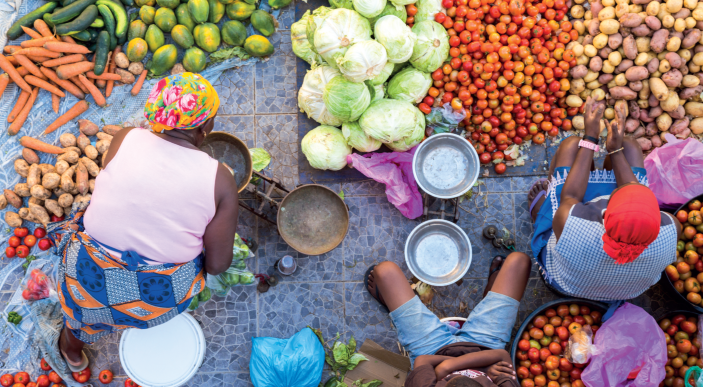Climate change is a confounding factor that can affect agriculture and food security in many different ways. Climate-resilient food systems are needed to ensure food security and to support mitigation efforts.
World Food Day — 16 October, with the theme this year of ‘leave no one behind’ — is an appropriate time to reflect on global progress toward Sustainable Development Goal 2: Zero Hunger. The 2022 Global Hunger Index, released October 2022 (https://www.globalhungerindex.org/), highlights that progress has stagnated, with the war in Ukraine, climate change and related extreme events, and the related increased price of food, fuel and fertilizer all contributing. The 2022 Global Hunger Index report1 highlights that 44 countries are currently suffering serious or alarming levels of hunger, although there is large within-country variability. The report estimates that 828 million people are currently undernourished, with parts of Africa south of the Sahara and South Asia having the highest hunger levels, and being the most vulnerable to future shocks.

Climate change can affect crops in different ways and the impacts of climate change due to higher levels of atmospheric CO2 are often deleterious. While higher levels of atmospheric CO2 may enhance photosynthesis and growth in some crops2, there isn’t a clear picture on the overall effects on crops. Further, it has been reported that plants grown under higher CO2 levels have changed nutritional value3.
Warming temperatures due to climate change also impact crop productivity, with an example discussed in this issue of Nature Climate Change. In an Article, Peng Zhu and colleagues consider how warming temperatures affect cropping frequency and yields. They find that warmer temperatures are increasing productivity and the possibility of multiple cropping seasons in cold regions, but increased temperatures in warm regions are causing decreases that outweigh the cold-region increases for an overall loss in crop productivity. The authors note that irrigation can offset the losses in warm regions, but water availability and the infrastructure needed suggest that the required 5% expansion of irrigation areas would be difficult to achieve.
Research has highlighted the risks of concurrent regional droughts; for example, work looking at 26 main crop-producing countries that found the probability under a high-emissions scenario to be at least 5% compared with 0% in the historical period4, as well as work showing increases by 40–60% for 10 global regions, with disproportionate risk increase across North America and the Amazon region5. With many regions relying on rain-fed agriculture, drought is a major risk to crop failure.
The shifting of seasons, in particular wet periods, can also affect planting. The northern USA had heavy spring rains this year that limited corn planting. This reduced planting led the US Department of Agriculture to lower the predicted yield per acre by 4 bushels, which equals more than 9 million tonnes less corn crop across the country. This lower yield, alongside lower-than-expected grain harvests in China, India, South America and part of Europe, reduced the available produce, not only for consumption but also for stock feed.
As well as their impact on production, extreme events can be a major disruption of supply chains. Yet, international trade has been highlighted as a possible way to mitigate climate change impacts on food security. It has been shown that high-emissions climate scenarios lead to increased hunger risk of 33–47% when trade is restricted, but decreases to 11–64% when trade is open6. However, production for export does need to be carefully considered to minimize negative effects in the producing region7.
The need to transform food systems to ensure resilience to climate change and other external pressures is well recognized, yet in climate change discussions it has not always been at the fore; at COP27, there will be a Food Systems Pavilion for the first time. How to achieve food systems transformation needs careful consideration and discussion, but work needs to begin now to push past the current stagnation and to ensure that no one is left behind.
References
von Grebmer, K. et al. 2022 Global Hunger Index: Food Systems Transformation and Local Governance (Welthungerhilfe, Concern Worldwide, 2022).
Toreti, A. et al. Nat. Food 1, 775–782 (2020).
Dong, J., Gruda, N., Lam, S. K., Li, X. & Duan, Z. Front. Plant Sci. https://doi.org/10.3389/fpls.2018.00924 (2018).
Qi, W., Feng, L., Yang, H. & Liu, J. Geophys. Res. Lett. 49, e2021GL097060 (2022).
Singh, J. et al. Nat. Clim. Change 12, 163–170 (2022).
Janssens, C. et al. Nat. Clim. Change 10, 829–835 (2020).
The State of Food Security and Nutrition in the World 2022. Repurposing Food and Agricultural Policies to Make Healthy Diets More Affordable (FAO, IFAD, UNICEF, WFP, WHO, 2022); https://doi.org/10.4060/cc0639en
Rights and permissions
About this article
Cite this article
Food insecurity. Nat. Clim. Chang. 12, 963 (2022). https://doi.org/10.1038/s41558-022-01530-2
Published:
Issue Date:
DOI: https://doi.org/10.1038/s41558-022-01530-2
This article is cited by
-
Feeding the future world
Nature Climate Change (2024)
